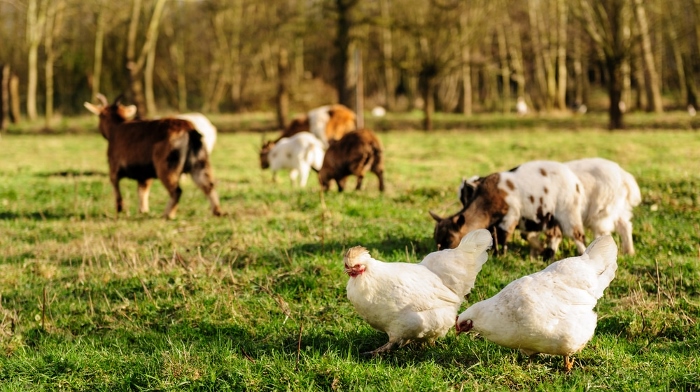Multi species grazing entails having different species of livestock and even poultry grazing in a pasture at the same time. Grazing on the average smallholding is usually at a premium, with most of us only having two or three fields. We should therefore give some thought to multi species grazing.
Advantages Of Mixed Grazing
Increased forage utilisation and efficiency ~ each species differs in the way it grazes and what it prefers to eat. Cattle eat forages that can be grabbed by the tongue to be pulled into the mouth and bitten off. The horse is a biting top-grazer. Horses graze off the tops until the pasture in that spot is short. Goats are browsers, grazing mainly at head height and above by standing on their back feet.
Sheep typically graze with their heads down but occasionally will graze at head height and above. Because of their split upper lip and smaller head, sheep typically graze closer to the ground than cattle and prefer to graze the smaller, more tender forages. This means heavier stocking rates and increased production from a unit of land.

Each species favours certain plants and if you have them together in the same field most of the plants will be evenly grazed. Grazing multiple species can also decrease undesirable plant populations. Although they are not as selective in what they graze, cattle usually graze the common grasses and legumes and leave less desirable forages such as weeds and forbs.
Goats, on the other hand, prefer to browse woody brush, shrubs, forbs, and many problem weeds. Sheep often choose to graze forbs over grasses and can be good at controlling many weeds. Cattle will graze the taller grass that sheep may reject. When deciding which species to add to a grazing system, it is best to evaluate current plant species in the meadow and determine which are not being grazed.
Mixed grazing allows us to take advantage of the fact that sheep and/or goats are more adapted to grazing on steep terrain or rocky areas while cattle prefer moderate slopes and flatter pastures.
Curbing Parasites
Multi species grazing helps in the management of internal parasites. Because parasites in cattle cannot survive in sheep and goats and vice versa, grazing multiple species can decrease gastrointestinal parasite loads and slow resistance to anthlementics. We usually find parasites in the first four inches of forage growth. So if parasite loads are high, small farmers should graze cattle first to consume a large amount of these parasites. This uses the leader-follower grazing system to reduce parasites in the small ruminants.
Research has shown that mixed grazing results in earlier weaning and increased lamb performance. It also results in increased body weight of ewes.
You can also consider keeping ducks with pigs, as the ducks will benefit by titbits found where pigs have been rooting.

Challenges of Multi Species Grazing
However, smallholders need to be aware of some other factors.
- Different species have varying fencing requirements, so it is sometimes a challenge to have fencing that will keep all the species in the field.
- The mineral requirements of the different species vary, so the use of lick blocks will be problematic. For example, sheep cannot tolerate the levels of copper that are required by cattle. So the sheep cannot have access to cattle supplements.
- It will probably be necessary to leave a field fallow for a season or two, in order for the plants to recover.
- There is sometimes a danger of diseases being passed from one species to another. Poultry can pass on tuberculosis to cattle and also infect pigs, so they should not be kept together.
To read more about livestock click here.
To subscribe to SA Smallholder click here.

